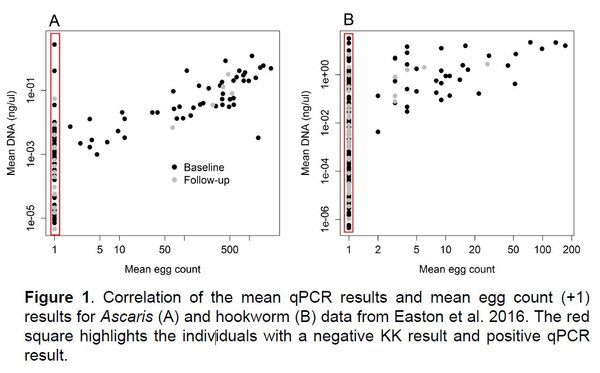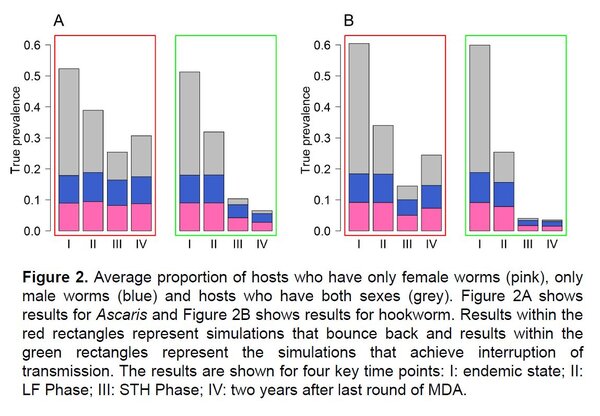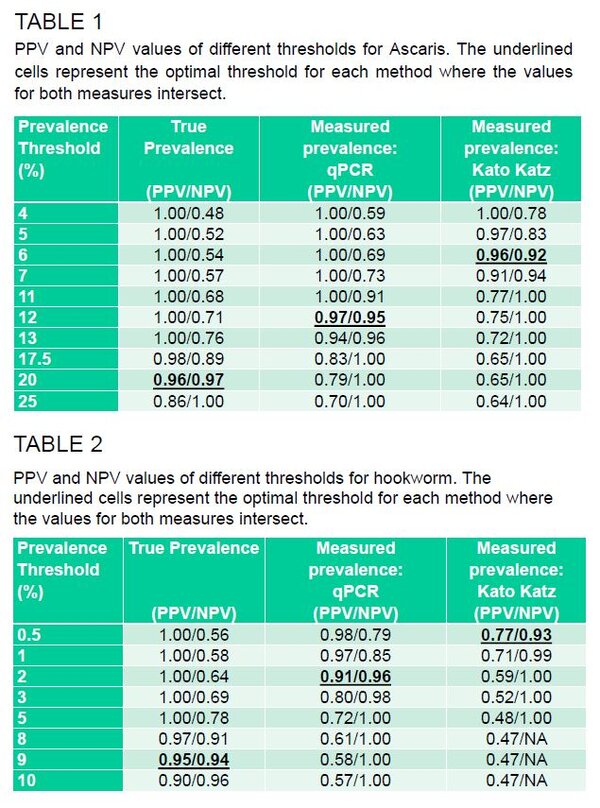ASTMH 2017 Poster - Testing for STH elimination: modelling the impact of different diagnostic tools
This page was adapted from a poster presented at ASTMH 2017 by M. Werkman, J.E. Truscott, J.E. Wright, A.V. Easton, R.G. Oliveira, J. Toor, A. Ower, K.H. Ásbjörnsdóttir, A.R. Means, S. Farrell, J.L. Walson, R.M. Anderson.
In recent years, an increased focus has been placed upon the possibility of the elimination of soil -transmitted helminth (STH)transmission using various interventions including including mass drug administration. The primary diagnostic tool recommended by the WHO is the detection of STH eggs in stool using the Kato-Katz (KK) method.
Detecting infected individuals using this method becomes increasingly difficult as the prevalence intensity of infection decreases. Newer techniques, such as qPCR, have been shown to have greater sensitivity than KK, especially at low prevalence.
The impact of using qPCR on elimination thresholds is yet to be investigated. This paper aims to quantify how the sensitivity of these two diagnostic tools affects the optimal prevalence threshold at which to declare the interruption of transmission with a defined level of confidence.
Methods
A stochastic, individual -based STH transmission model was used in this study to simulate the transmission dynamics of Ascaris and hookworm .Data from a Kenyan deworming study were used to parameterize the diagnostic model which was based on egg detection probabilities.The positive and negative predictive values (PPV and NPV) were calculated to assess the quality of any given, threshold, with the optimal threshold value taken to be that at which both were maximised .The PPV and NPV are the theproportion proportion of positive and negative results in the trials that are true positive (elimination transmission) and true negative results(bounce back occurs), respectively.
Results
Figure 1 shows the relationship between mean DNA concentration (ng/µL) and the mean egg count +1 for Ascaris (A) and hookworm (B) from the results recorded in Easton et al .[16 ].The red square highlights the hosts that had zero egg count but were found positive with qPCR .The egg counts from KK and the DNA quality provided by qPCR show avery strong positive relationship, we apply apply these data in this study to investigate the importance of diagnostic sensitivity on declaring interruption of transmission.
To achieve interruption of transmission, the number of individuals harbouring worms of both both sexes needs to become so low that the likelihood of successful successful mating falls below the level required to maintain the parasite population. Figure 2 shows the combination of individuals with only male worms, only female worms, or worms of both sexes at four key time points,from our simulations of worm loads in individuals.
The threshold prevalence of infection values for declaring elimination of Ascaris transmission were were 6% and 12% for KK and qPCR respectively (table 1). For hookworm, these threshold values are lower at 0.5% and 2% respectively (table 2).
Conclusion
Diagnostic Diagnostic tests with greater sensitivity are becoming increasingly important as we approach the elimination of STH transmission in some regions of the world.Using qPCR to diagnose STH infection requires a higher prevalence thresholds to be used for declaring elimination. However, there are currently currently no “gold standards” for the detection STH infections aside from the the faecal egg detection methods by microscopy or floatation .Even though the use of qPCR presents a number of important challenges, its high sensitivity makes it a very valuable tool in working towards the elimination of STH species.
References
Easton AV, Oliveira RG, O'Connell EM, Kepha S, Mwandawiro CS, Njenga SM, Kihara JH, Mwatele C, Odiere MR, Brooker SJ, Webster JP, Anderson RM, Nutman TB (2016) Multi-parallel qPCR provides (increased sensitivity and breadth for gastrointestinal parasites parasites of humans : field -based based inferences on the impact of mass deworming. Parasite & Vectors. 2016 Jan 27;9:38


